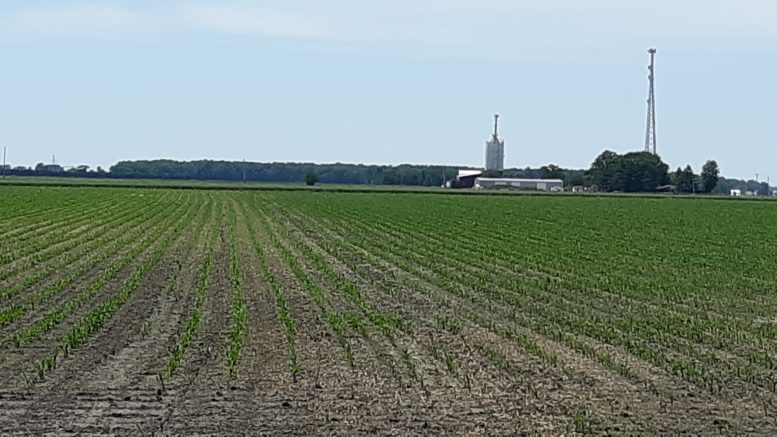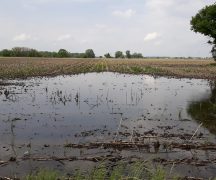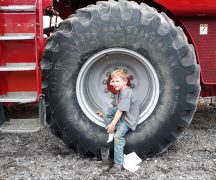By JAN LARSON McLAUGHLIN
BG Independent News
This time last year, Wood County’s farm fields were flooded and farmers were frustrated.
Ag experts were predicting that 90 percent of the farm crop in Wood County would go unplanted in 2019. That turned out to be an optimistic estimate.
Farmers watched and waited as a series of drenching rains just kept pounding away at the area that was already hurting from an unprecedented wet spring.
“It was kind of heartbreaking,” farmer Paul Herringshaw said a year ago as he watched another 5 inches of rain drown his dreams of planting.
“I have never been in this situation before,” said Herringshaw, who farms in Liberty Township south of Bowling Green.
But this year is a different story – promising a happier ending for the farm season. Rows of corn and soybeans are turning barren fields to green growth.
“It has been a great relief,” Herringshaw said about the weather cooperating with the planting season. “We’re pretty well completed planting.”
There was one storm last month that dumped 3.5 inches of rain on Herringshaw’s fields, and required that some patches be replanted. But that’s a miniscule problem compared to last year.
Wood County just happens to be in the “garden spot this year,” said Marc Schaller, general manager of Countyline Co-op in Pemberville.
“It started as a complete opposite of last year,” he said. “We should be significantly better this year.”
Most farmers in the area planted cover crops last year after they were forced to give up on their regular soybean and corn seeds.
“For the most part, the soil handled it pretty good,” Herringshaw said.
The cooperative weather has been good for the farming community.
“You’re actually accomplishing something,” Herringshaw said. “If you can’t plant, you can’t harvest. We would get close, then it would rain again.”
“If you’re an old guy like me, who’s used to always getting a window to plant,” it was hard to watch, he said.
Herringshaw remembered his son asking him if his grandfather ever experienced a year like last year. Never, he said.
Like most farmers, Herringshaw has crop insurance – but said it is a poor substitute for producing a crop.
“Even if you had great crop insurance, you’ll never get ahead with insurance,” he said.
The plight of local farms was so serious last summer that Gov. Mike DeWine came to Perrysburg Township farmer Kris Swartz’ fields to view the damage and talk with farmers.
“We’ve had some years that were tough, but not like this,” Swartz told the governor as they looked over a wheat field drowned out by 54 days of rain between April and mid-June.
Beyond affecting the profits, the poor planting season also led to sunken morale for local farmers.
“We’re kind of like the date that got dressed up for the prom and nobody picked us up,” Swartz said. “The farm community is pretty down.”
Mark Drewes, who farms in the Custar area, normally grows corn for local dairies. He told Dewine about being unable to get any corn in the ground.
“We’ve had drought and wet weather before, but nothing like these historical proportions,” he said. “These cows have to have feed.”
There were concerns that the lack of crops last year would lead to a shortage of seed to plant this year. But that concern appears to be unwarranted, though some of the seed came from as far away as South America.
Though this year’s crops are in the ground, farmers are facing other challenges this year, Herringshaw said.
Since COVID-91 has led people to drive far less, the demand for corn to produce ethanol has taken a dive.
“Those markets have not been very strong,” Herringshaw said.
Some ethanol plants have retooled to produce hand sanitizer in response to the pandemic.
“That’s certainly going to help the farmers,” Schaller said.
But there are other factors at play, Schaller said. A swine illness in China has led to a collapse in corn and soybean demands there. And there’s talk of huge excesses of crops being possible.
So there may be bumper crops, but with disappointing prices, Schaller said.
In a cruel twist, the crop prices were good last year – but local farmers couldn’t get their fields planted. This year their crops are in the ground, but prices have tanked.
“Grain prices are terrible. This is an unbelievably weird time,” Schaller said. “The farmers are really going to be pressed from a pricing standpoint.”
Such is the life of farmers, he said.
“The farmer has so much out of his control,” Schaller said.
Farmers can control how hard they work – but Mother Nature and the markets are outside their power.
“They are going to be under a great deal of pressure for the next 12 months or so,” Schaller said. “But I think the farmers’ mindset has been really positive.”
And now, one year after being deluged by downpours, local fields could actually use some nice gentle rains. “It wouldn’t really hurt to get some rain – as long as it didn’t require an ark,” Herringshaw said.





